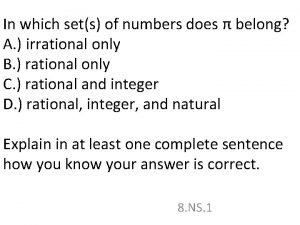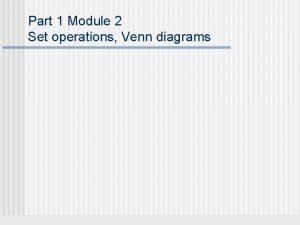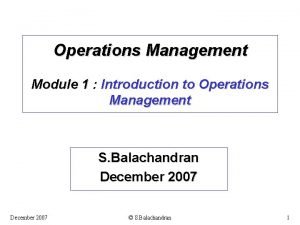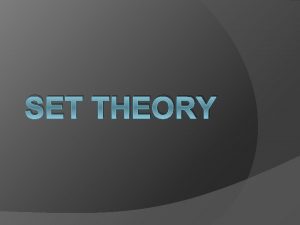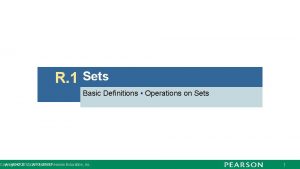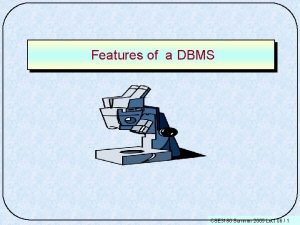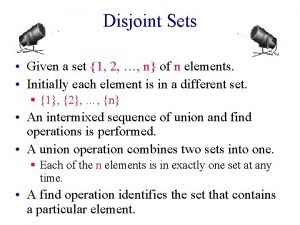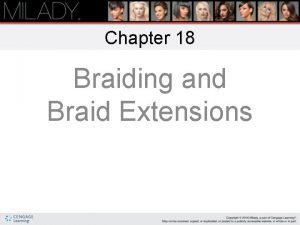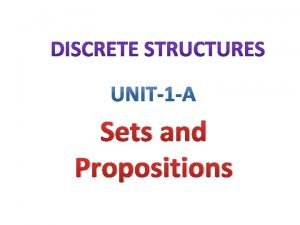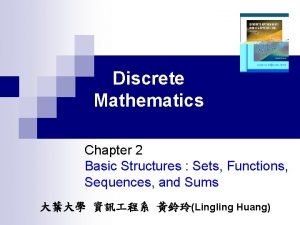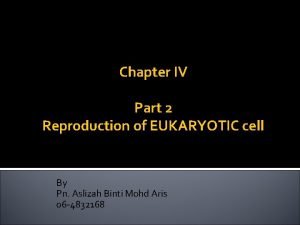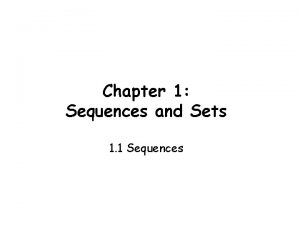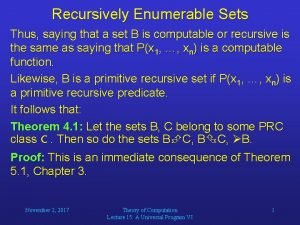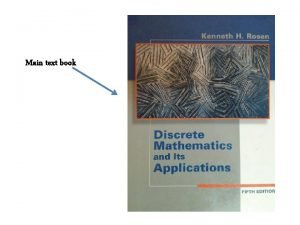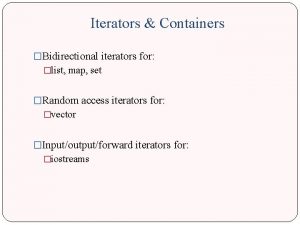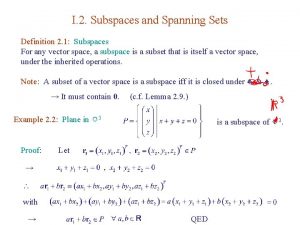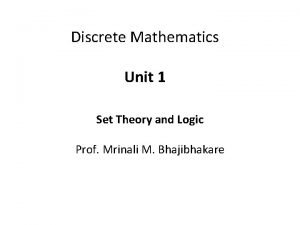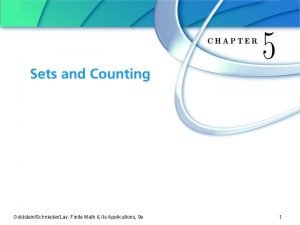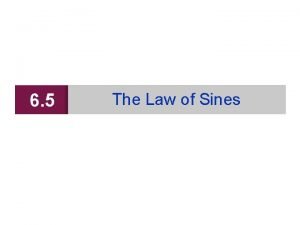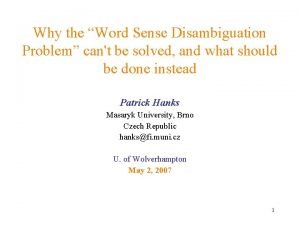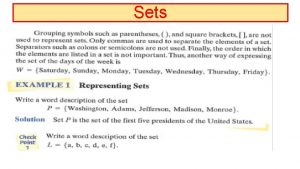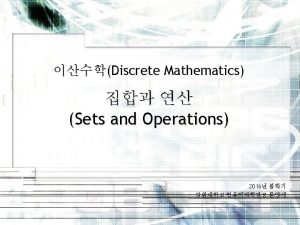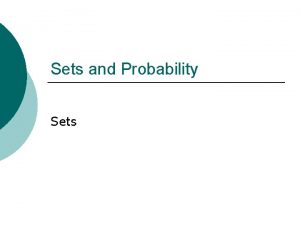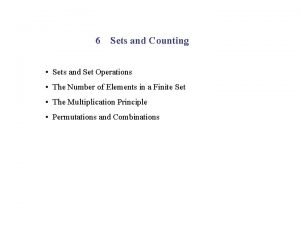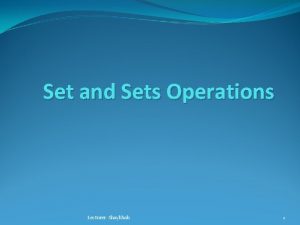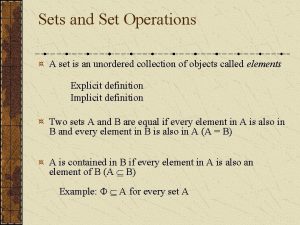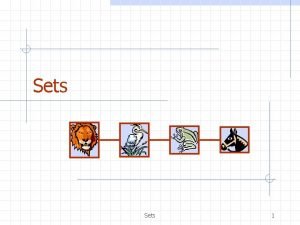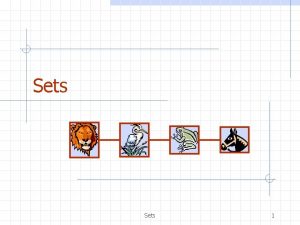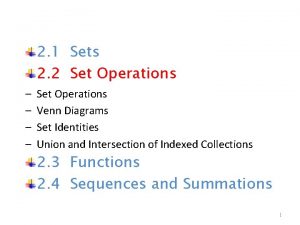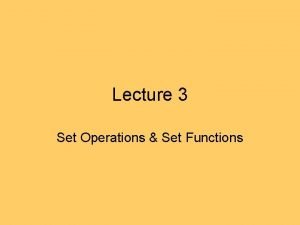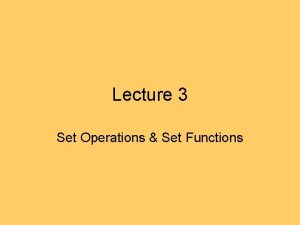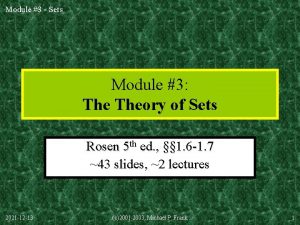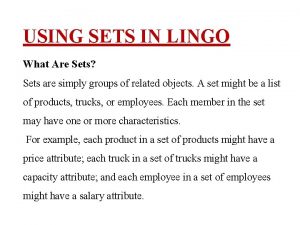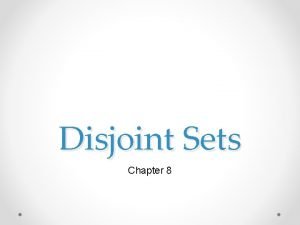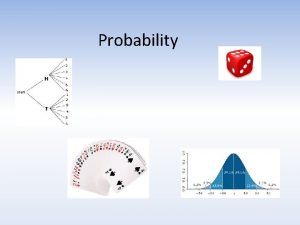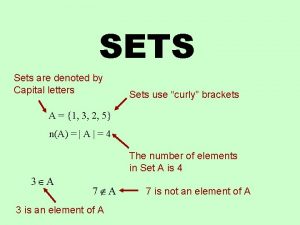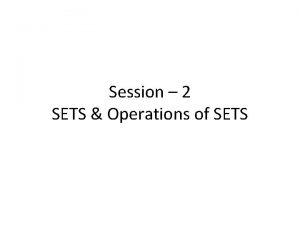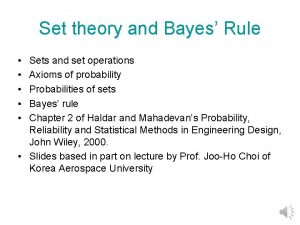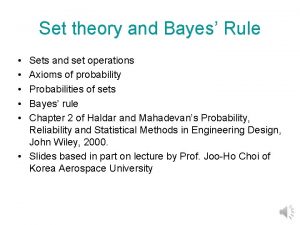Module 3 Sets 2 Sets and Set Operations


































- Slides: 34

Module #3 - Sets 2. Sets and Set Operations 10/27/2021 (c)2001 -2003, Michael P. Frank

Module #3 - Sets Section 2. 1: Sets • Set is a collection of distinct unordered objects. • Members of a set are called elements. • For example: § A = {1, 3, 5, 7}; 3 A , 2 A § B = {Cat, Dog, Fox} § C = {x | x = n 2 + 1, n is an integer, 0 ≤ n ≤ 10} § D = {x | 1 ≤ x ≤ 4} = [1, 4] 10/27/2021 (c)2001 -2003, Michael P. Frank

Module #3 - Sets Basic Notations for Sets (1) listing all of its elements in curly braces: - Finite sets: V = {a, e, i, o , u} S = {1, 2, 3, … , 99} - Infinite sets: N = {0, 1, 2, …}, The set of natural numbers Z = {…, -2, -1, 0, 1, 2, …}, The set of integers Z+ = {1, 2, 3, …}, The set of positive integers R = The set of real numbers 10/27/2021 (c)2001 -2003, Michael P. Frank

Module #3 - Sets Basic Notations for Sets (2) Set builder notation: For any proposition P(x) over any universe of discourse, {x | P(x)} is the set of all x such that P(x). Example “The set of all odd positive integers less than 10” O = {x | x is an odd positive integer and x < 10} 10/27/2021 (c)2001 -2003, Michael P. Frank

Module #3 - Sets Examples Use the set builder notation to describe the sets A = {1, 4, 9, 16, 25, …} B = {a, d, e, h, m, o} A = { x | x = n 2 , n is positive integer} B = { x | x is a letter of the word mohamed} 10/27/2021 (c)2001 -2003, Michael P. Frank

Module #3 - Sets Basic Notations for Sets (3) Venn Diagrams U : universal set S John Venn 1834 -1923 10/27/2021 (c)2001 -2003, Michael P. Frank

Module #3 - Sets Membership in Sets • x S : x is an element or member of the set S. e. g. 3 N “a” {x | x is a letter of the alphabet} • x S : (x S) “x is not in S ” 10/27/2021

Module #3 - Sets The Empty Set • (null or the empty set) is the unique set that contains no elements. • = {} • Empty set does not equal the singleton set { } ≠ { } 10/27/2021 (c)2001 -2003, Michael P. Frank

Module #3 - Sets Definition of Set Equality • Two sets are declared to be equal if and only if they contain exactly the same elements. i. e. A and B are equal if and only if x (x A x B ) Example: (Order and repetition do not matter) {1, 3 , 5} = {3, 5, 1} = {1, 3, 3, 3, 5, 5, 5} 10/27/2021 (c)2001 -2003, Michael P. Frank

Module #3 - Sets Subset Relation • S T (“S is a subset of T”) means that every element of S is also an element of T. • S T x (x S x T ) • S S • If S T is true and T S is true then S = T , x (x S x T) • means (S T ), i. e. x (x S x T ) 10/27/2021 (c)2001 -2003, Michael P. Frank

Module #3 - Sets Proper Subset • S T (S is a proper subset of T ) means every element of S is also an element of T, e. g. but S T. {1, 2} {1, 2, 3} S T Venn Diagram equivalent of S T 10/27/2021 (c)2001 -2003, Michael P. Frank

Module #3 - Sets Are Objects, Too! • The objects that are elements of a set may themselves be sets. e. g. let S = {x | x {1, 2, 3}} then S = { , {1}, {2}, {3}, {1, 2}, {1, 3}, {2, 3}, {1, 2, 3}} • Note that 1 {1} {{1}} !!!! 10/27/2021 12

Module #3 - Sets Cardinality and Finiteness • |S| or card(S) (read the cardinality of S ) is a measure of how many different elements S has. e. g. | | = |{ }| = 0 |{1, 2, 3, 5}| = 4 |{a, b, c}| = 3 |{{1, 2, 3}, {4, 5}}| = 2 10/27/2021 (c)2001 -2003, Michael P. Frank

Module #3 - Sets The Power Set Operation • The power set P(S) of a set S is the set of all subsets of S. e. g. § P({a, b}) = { , {a}, {b}, {a, b}} § P({1, 2, 3}) = { , {1}, {2}, {3}, {1, 2}, {1, 3}, {2, 3}, {1, 2, 3}} § P({a}) = { , {a}} § P({ }) = { , { }} § P( ) = { } Note: If a set has n elements then P(S) has 2 n elements. 10/27/2021 (c)2001 -2003, Michael P. Frank

Module #3 - Sets Ordered n-tuples • The ordered n-tuple (a 1, a 2, …, an) is the ordered collection that has a 1 as its first element, a 2 as its second element and so on. • These are like sets, except that duplicates matter, and the order makes a difference. e. g. (2, 5, 6, 7) is a 4 -tuple. • Note that (1, 2) (2, 1, 1). • Note: 2 -tuples are called ordered pairs. 10/27/2021 (c)2001 -2003, Michael P. Frank

Module #3 - Sets Cartesian Products of Sets • The Cartesian product of any two sets A and B is defined by A B : {(a, b) | a A b B }. e. g. {a, b} {1, 2} = {(a, 1), (a, 2), (b, 1), (b, 2)} • Note that for finite A and B, |A B| = |A||B|. • Note that the Cartesian product is not commutative: A B ≠ B A. e. g. {1, 2} {a, b} = {(1, a), (1, b), (2, a), (2, b)} 10/27/2021 (c)2001 -2003, Michael P. Frank

Module #3 - Sets Section 2. 2: Set Operations The Union Operator • For any two sets A and B, A B is the set containing all elements that are either in A, or in B or in both. • Formally: A B = {x | x A x B}. 10/27/2021 (c)2001 -2003, Michael P. Frank

Module #3 - Sets Union Example {2, 3, 5} {3, 5, 7} = {2, 3, 5, 7} ={2, 3, 5, 7} 10/27/2021 (c)2001 -2003, Michael P. Frank

Module #3 - Sets The Intersection Operator • For any two sets A and B, their intersection A B is the set containing all elements that are in both A and in B. • Formally: A B = {x | x A x B}. 10/27/2021 (c)2001 -2003, Michael P. Frank

Module #3 - Sets Intersection Examples • {a, b, c} {2, 3} = disjoint • {2, 4, 6} {3, 4, 5} = {4} 10/27/2021 (c)2001 -2003, Michael P. Frank

Module #3 - Sets Inclusion-Exclusion Principle • How many elements are in A B? |A B| = |A| |B| |A B| Example: {1, 2, 3} {2, 3, 4, 5} = {1, 2, 3, 4, 5} {1, 2, 3} {2, 3, 4, 5} = {2, 3} |{1, 2, 3, 4, 5}| = 3 + 4 – 2 = 5 10/27/2021 (c)2001 -2003, Michael P. Frank

Module #3 - Sets Set Difference • For any two sets A and B, the difference of A and B, written A B, is the set of all elements that are in A but not in B. A B : x x A x B x x A x B A – B = A B is called the complement of B with respect to A. e. g. {1, 2, 3, 4, 5, 6} {2, 3, 5, 7, 9, 11} = {1, 4, 6 } 10/27/2021 (c)2001 -2003, Michael P. Frank

Module #3 - Sets Set Difference - Venn Diagram Set A B Set A 10/27/2021 Set B (c)2001 -2003, Michael P. Frank

Module #3 - Sets Symmetric Difference • For any two sets A and B, the symmetric difference of A and B, written A B, is the set of all elements that are in A but not in B or in B but not in A. A B : x (x A x B) (x B x A) (A – B) (B – A) = (A B) – (A B) e. g. {1, 2, 3, 4, 5, 6} 7, 9, 11} 10/27/2021 {2, 3, 5, 7, 9, 11} = {1, 4, 6, (c)2001 -2003, Michael P. Frank

Module #3 - Sets Symmetric Difference - Venn Diagram Set A B Set B A Set A 10/27/2021 Set B (c)2001 -2003, Michael P. Frank

Module #3 - Sets Set Complements • U : Universe of Discourse : For any set A U, the complement of A, i. e. it is U A. A e. g. If U = N, 10/27/2021 U (c)2001 -2003, Michael P. Frank

Module #3 - Sets Example Let A and B are two subsets of a set E such that A B = {1, 2}, |A|= 3, |B| = 4, A = {3, 4, 5, 9} and B = {5, 7, 9}. Find the sets A, B and E. E A 7 1 2 3 B 4 5 9 A = {1, 2, 7}, B = {1, 2, 3, 4}, E = {1, 2, 3, 4, 5, 7, 9} 10/27/2021 (c)2001 -2003, Michael P. Frank

Module #3 - Sets Set Identities Identity: A = A U Domination: A U = U , A = Idempotent: A A = A A Double complement: Commutative: A B = B A , A B = B A Associative: A (B C) = (A B) C • Distribution: A (B C) = (A B) (A C) • De Morgan’s Law: • • • 10/27/2021 (c)2001 -2003, Michael P. Frank

Module #3 - Sets Proving Set Identities • To prove statements about sets of the form E 1 = E 2, where the Es are set expressions, there are three useful techniques: 1. Proving E 1 E 2 and E 2 E 1 separately. 2. Using set builder notation and logical equivalences. 3. Using set identities. 10/27/2021 (c)2001 -2003, Michael P. Frank

Module #3 - Sets Example: Show A B = A B Method 1: Prove E 1 E 2 and E 2 E 1 Assume x A B by the definition of the complement x A B by the definition of the negation ((x A) (x B)) by the definition of intersection (x A) ( x B) by De Morgan’s law x A x B by the definition of negation x A x B by the definition of the complement x A B by the definition of union 10/27/2021 (c)2001 -2003, Michael P. Frank

Module #3 - Sets Method 2: Set Builder Notation Show A B = A B A B = {x | x A B} = {x | ( x (A B))} = {x | ( x A x B)} = {x | x A x B} = {x | x A x B)} = {x | x A B } = A B (c)2001 -2003, Michael P. Frank 31

Module #3 - Sets Method 3 : Using Set Identities 10/27/2021 (c)2001 -2003, Michael P. Frank

Module #3 - Sets Method 3 : Using Set Identities 10/27/2021 (c)2001 -2003, Michael P. Frank

Module #3 - Sets Computer Representation of Sets • Let U = {1, 2, 3, 4, 5, 6, 7, 8, 9, 10}. The bit string (of length |U| = 10) that represents the set A = {1, 3, 5, 6, 9} has a one in the first, third, fifth, sixth, and ninth position, and zero elsewhere. It is 1 0 1 1 0 0 1 0. 10/27/2021 (c)2001 -2003, Michael P. Frank
 Total set awareness set consideration set
Total set awareness set consideration set Training set validation set test set
Training set validation set test set What set or sets of numbers does 450 belong?
What set or sets of numbers does 450 belong? A-b shaded venn diagram
A-b shaded venn diagram C device module module 1
C device module module 1 What is the overlap of data set 1 and data set 2?
What is the overlap of data set 1 and data set 2? Operations management module
Operations management module Improper subset
Improper subset R set operations
R set operations Traditional set operations in dbms
Traditional set operations in dbms Ackermann function complexity
Ackermann function complexity Bounded set vs centered set
Bounded set vs centered set Crisp set vs fuzzy set
Crisp set vs fuzzy set Crisp set vs fuzzy set
Crisp set vs fuzzy set Crisp set vs fuzzy set
Crisp set vs fuzzy set The function from set a to set b is
The function from set a to set b is Fuzzy sets and fuzzy logic theory and applications
Fuzzy sets and fuzzy logic theory and applications Explain the use of the square paddle brush in braiding
Explain the use of the square paddle brush in braiding Sets and propositions
Sets and propositions Onto function
Onto function Chromosome sets (=n) in mitosis and meiosis
Chromosome sets (=n) in mitosis and meiosis Anaphase meaning
Anaphase meaning Arithmetic sequence sigma notation
Arithmetic sequence sigma notation Recursive and recursively enumerable sets
Recursive and recursively enumerable sets Finite and infinite sets
Finite and infinite sets Sets and maps java
Sets and maps java Maps and sets support bidirectional iterators.
Maps and sets support bidirectional iterators. Minimum spanning set
Minimum spanning set Set theory and logic discrete mathematics
Set theory and logic discrete mathematics Finite math
Finite math A pilot sets out from an airport and heads in the direction
A pilot sets out from an airport and heads in the direction The collection of well defined objects is called
The collection of well defined objects is called Module 5 supply and demand introduction and demand
Module 5 supply and demand introduction and demand 4 sided shape
4 sided shape Lexical sets
Lexical sets


